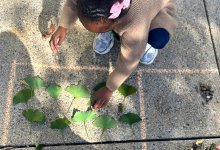Critical Thinking
Whether via classroom discussions, analysis of written text, higher-order questioning, or other strategies, learn and share ways to help students go deeper with their thinking.
9 Ways to Teach Spatial Thinking Across the Curriculum
Strong spatial skills are critical for everyday tasks and across many careers—they also strengthen students’ math performance.231Your content has been saved!
Go to My Saved Content.Using Picture Books to Teach Children About Large Numbers
These strategies help elementary students grapple with the very large numbers involved in talking about time and space.Your content has been saved!
Go to My Saved Content.Exploring Before Explaining Sparks Learning
New elementary science teachers can build student engagement and enhance learning by using the explore-before-explain approach.Your content has been saved!
Go to My Saved Content.Fall Math Manipulatives: Pumpkins, Leaves, and More
Students can get hands-on by incorporating natural objects into curiosity-driven math lessons like measuring and sorting.108Your content has been saved!
Go to My Saved Content.7 Ways to Get Math Students to Show Their Thinking
Math isn’t just about answers—the process matters, too. These strategies spotlight reasoning and reveal student thinking.4.4kYour content has been saved!
Go to My Saved Content.Adapting Socratic Seminars for Elementary
With a few key modifications, teachers can make a complex academic discussion into an excellent learning opportunity for younger students.Building Students’ Number Sense in Elementary Math
To get an internal sense of how numbers relate to each other, students can practice working with number lines.Using Error Analysis to Boost Engagement and Student Talk in Math
Examining mistakes gives students a chance to discuss misconceptions openly and find new approaches to solving problems.16 Variations on Think-Pair-Share to Keep Students Engaged
Teachers and students use this classic learning strategy often. To keep it from getting stale, try these tweaks.9 Ways to Teach Students the Value of Slow, Methodical Thinking
Quick thinking has its place in the classroom, but students who also master slower, more deliberate thinking develop the skills to know when each approach serves them best.1.1kYour content has been saved!
Go to My Saved Content.Using Tech Tools to Amplify Classroom Thinking Routines
Integrating digital tools empowers students with choice, while making thinking increasingly visible and collaborative—creating a more accessible and dynamic classroom culture.558Your content has been saved!
Go to My Saved Content.15 Formative Assessment Hacks to Boost Students’ Learning
Common formative assessment techniques can work a little better with these simple tweaks.Designing a Course That Develops Students’ Metacognition
By shifting their focus to the process of learning instead of the product, students are encouraged to develop critical cognitive competencies.Why Students Should Write in All Subjects
Writing improves learning by consolidating information in long-term memory, researchers explain. Plus, five engaging writing activities to use in all subjects.19kYour content has been saved!
Go to My Saved Content.Encouraging Students to Use Notes for Sense-Making
Middle school teachers can use these strategies to help students learn how to get the most value out of their notes.2kYour content has been saved!
Go to My Saved Content.













